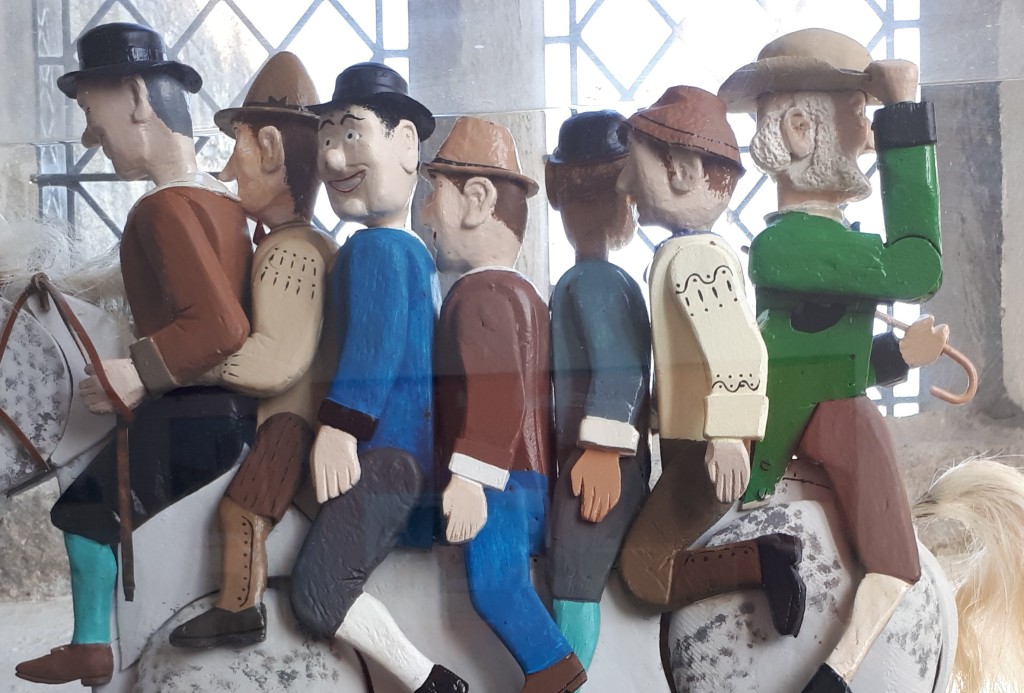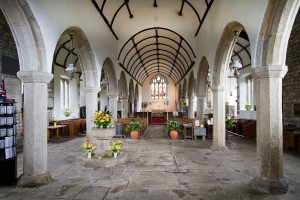Beyond the Moor – a connected rural church
By Susan Miller (November 2021)
Dartmoor means narrow roads, isolation, big skies, sheep, ponies and lots of bracken and heather. On holiday at Widecombe in the Moor this September, we found all of those things – and also a welcoming village church, St Pancras, which we realised was very well connected to the world beyond the Moor.
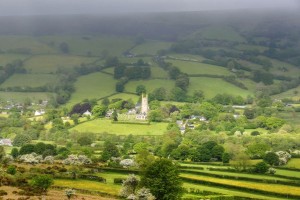 Situated in the centre next to the green, it is very much part of the village, which attracts thousands of visitors a year, with three to four coaches per day in the summer. You first see the 120-ft. tower rising out of the surrounding moors and then the picturesque churchyard, and then, once you enter the church, there is an overwhelming sense of space and peace (the church is open from 9am to 5pm every day).
Situated in the centre next to the green, it is very much part of the village, which attracts thousands of visitors a year, with three to four coaches per day in the summer. You first see the 120-ft. tower rising out of the surrounding moors and then the picturesque churchyard, and then, once you enter the church, there is an overwhelming sense of space and peace (the church is open from 9am to 5pm every day).
Information exhibition
The village of Widecombe is most famously linked to the folk song Widecombe Fair, which describes the tragic fate of the poor grey mare that is borrowed from Tom Pearce and as the chorus describes, is ridden to the fair by the motley group of ‘Bill Brewer, Jan Stewer, Peter Gurney, Peter Davy, Dan’l Whiddon, Harry Hawke, Uncle Tom Cobley and all’.
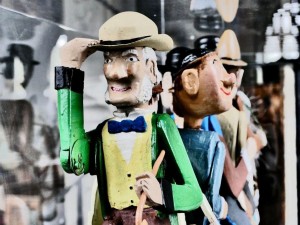 A side chapel in the church contains exceptionally well researched and attractively presented information in the form of models, three mounted noticeboards, an impressive guidebook and even a wooden statue of the poor old grey mare, staggering on its way to Widecombe Fair.
A side chapel in the church contains exceptionally well researched and attractively presented information in the form of models, three mounted noticeboards, an impressive guidebook and even a wooden statue of the poor old grey mare, staggering on its way to Widecombe Fair.
You can happily spend anything from five minutes to an hour reading and looking at everything, thanks to the efforts of the vicar, the Revd Geoffrey Fenton, and a group of committed people from the church and the village.
Visitor experience
I chatted to the vicar about the welcoming feel they’d achieved in the church and also the comprehensive display.
He confirmed that the church is open ‘every day, all day from dawn to dusk’. They had to close it during the pandemic, partly because of the cleaning regime that they were expected to follow if they had allowed visitors inside.
‘We still had large numbers of visitors and there was a time when you had to wipe down every surface every day and that just wasn’t practical for us,’ he said. But the church reopened as soon as possible after restrictions were eased and has been open all this summer.
Geoffrey Fenton has been in post as vicar for ten years, and five years ago he led the efforts by the church and village to apply for funding to increase ‘the quality of the visitor experience in Widecombe in the Moor, encouraging them [visitors] to stay longer and get a deeper understanding of the heritage of the area’. The aim of the project was to provide a coherent series of signs, displays and leaflets to ‘interpret the historic nature of specific buildings, tin mining and Victorian tourism, as well as the stories and people associated with the village.’ The funding came from a scheme called Moor Than Meets the Eye. This scheme is funded by the National Lottery Heritage Fund, and managed by the Landscape Partnership (LP) Board, made up of thirteen public, private and voluntary sector organisations with interests on Dartmoor.
The vicar says it was a big effort to co-ordinate the application and then deliver the projects. They put together a local team to do the research, the photography, writing the content and then designing the boards. ‘A professional designer put it all together and shipped it to us. And we put it in the church and in the pubs and around the village,’ he explained. ‘It was a lot of work [but] we had an enthusiastic team committee, including the Chairman of the History Society, and it was an integrated church and village effort.’
The team was also able to produce more than five hundred guidebooks, ‘which we sell for £2, so we ended up with some genuine income in addition to the general benefit’. The guidebooks can be updated and reprinted in future. The displays are also changed from time to time.
I was impressed by the three large information boards, which are beautifully presented. Geoffrey Fenton explains, ‘It was a lovely sort of gift. I am very pleased with the way that the stories of Widecombe, particularly the wartime history of the church roof and the details of our lovely carved roof corbels and our bells and bell ringers, are told. It’s all displayed, I think very, very well.’
The boards are on wheels so that they can be moved out of the way when space is needed on Remembrance Sunday or during other services.
A true sense of space and peace
What also struck me was the sense of space and light and peace inside St Pancras – the pews take up only half of the nave and there is a lovely open space at the back of the church. Geoffrey Fenton also points out that because St Pancras was in a poor district during the Victorian era it never obtained stained-glass windows like many other churches.
‘There is clear glass all along the south side and big windows so it can be a very bright, sunlit space. If the windows were stained glass it would be very pretty but it wouldn’t be so welcoming,’ he said.
Number of visitors
I asked Geoffrey Fenton, the vicar, if the project had increased the number of visitors and how important this was to the church
‘There’s lots of answers to that. We can look at it in a mercenary way and say that the more visitors we have the more we can sell from our little stalls and therefore the more money we make, so that’s to be encouraged.
‘We can say that the more visitors who come into the church, you know, the better their experience of a holiday in Widecombe is. So, improving the business life of the village by making it a sort of core attraction; people come to the pub, they come to the cafe and they visit the church.
‘But, clearly, if you look at the guidebook, it’s about trying to connect the building to the Christian faith. It talks about baptism, it talks about parts of the service, what the altar and altar rails are for. It’s trying to tell the story of a functioning living church in the context of its history and its past.
‘The same applies to services. During a normal service on a Sunday morning in summer, we very often have half a dozen visitors joining in.
‘So, it’s an integral part of the town and has been for 100 years, you know. Widecombe and our visitors are sort of seamlessly intertwined.’
One recent ‘innovation’ at St Pancras is that because of the numbers of hikers who visit the church, they have become dog friendly! ‘We should put up a notice really’, says the vicar. ‘When I was younger you wouldn’t dream of taking your dog into a church but now dogs are perfectly welcome. There are no barriers to people coming into the church and having a look around if they’re out for a walk, even with their dogs.’
The church has a number of small items on sale, costing about £3 each, and operates on a trust system whereby visitors are asked to pay the money into a wall safe. There is also an open bowl for making financial donations to the food bank and people have, for many years, been leaving money, mostly in cash. The bowl is emptied out ‘from time to time’. As Geoffrey says, ‘you know that money just sits there for anyone and maybe occasionally people help themselves if they’re in need. I like the idea of trust’.
Prayer flags
Visitors can light candles, read prayer cards and simply sit and enjoy the peace of the church.
For me, a most special feature were the small prayer flags, which visitors can take home with them, ‘carrying the prayers of St Pancras out into the world’.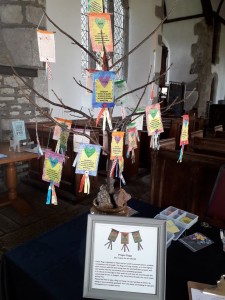
They are made of small pieces of wood and material by parishioner Penny Whale, who sews them at home. Penny was inspired by seeing the idea on Pinterest and also by a trip, just before the Covid pandemic, to a remote village in New Zealand.
‘The men had carved little crosses out of very basic bits of wood, nothing fancy, and when the lady showed us around she said please take one of these crosses and take our best wishes with you.
And I just thought it was such a lovely thing to do; I have still got the cross and I thought it would be nice to reciprocate.’
Visitors who take a prayer flag sign the book and say where they are from and where they are taking the flags. Penny says that reading the entries highlights that visitors come to Widecombe from ‘all parts of the world’.
She initially began with a Christmas tree of prayers but decided to keep making flags throughout this year because of the ‘sad state of the world in this time of pandemic’. She and others will be making 250 flags for the Christmas tree this year. They will last, she thinks, for the ten days of the Christmas Tree Festival in the church.
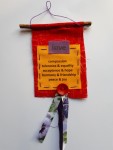 I brought a flag back to London and it is an inspiring thought that this remote Dartmoor church is connected to towns and villages – and people – all across the world.
I brought a flag back to London and it is an inspiring thought that this remote Dartmoor church is connected to towns and villages – and people – all across the world.
A place of stillness and quiet
Geoffrey Fenton says that the church’s location in the moor is very relevant to how they see themselves. ‘The church can work in tandem with the National Parks in the sense that the Parks increasingly feel it is their duty to offer visitors a positive experience and, if one thinks about it, that is precisely what the church is about – to engage with people and give them a positive experience. So we have a leaflet, for instance, encouraging people just to be silent and still, to go out on the Moor and just sit and reflect. Because lots of people come to the moor to experience stillness and to get away from all the paraphernalia of modern life, and I think that’s a pretty universal human hunger.
‘So, while most churches are pretty noisy through services and functions etc., we offer a place for stillness and quiet too. And so a lot of people come into the church, just to sit quietly.’
(However, the church is not always silent: it has a vibrant tradition of bell ringing, which was affected by Covid, just as its concerts were, but – as I can attest – is now very much back.)
St Pancras has many, many visitors and, with its good acoustics, the potential to host more concerts and choirs, but because it wants to remain accessible as a quiet place every day it has decided not to offer the space for private hire during the day. ‘Then we would have to stop people coming in and we don’t want to do that,’ said Geoffrey Fenton.
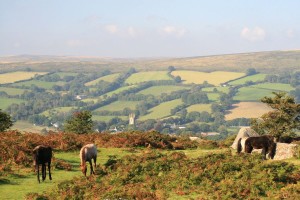 It’s a lovely church in a gorgeous village on Dartmoor, which can feel very remote but is ultimately very connected. I shall be thinking of the Christmas Service at St Pancras this year, with the distant hills surrounding the church and the building packed with locals and visitors from all over the world.
It’s a lovely church in a gorgeous village on Dartmoor, which can feel very remote but is ultimately very connected. I shall be thinking of the Christmas Service at St Pancras this year, with the distant hills surrounding the church and the building packed with locals and visitors from all over the world.

